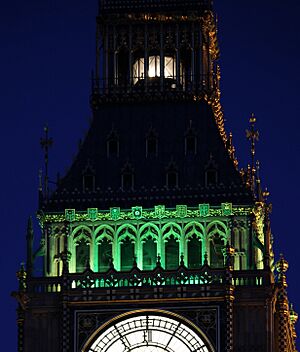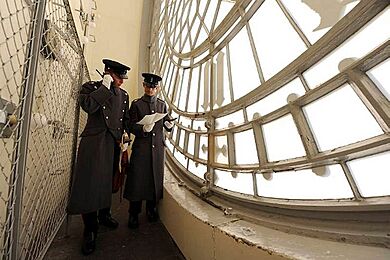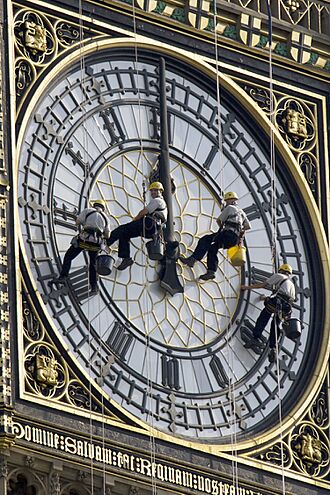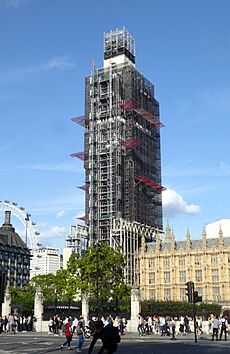Big Ben facts for kids
Quick facts for kids Big Ben |
|
|---|---|
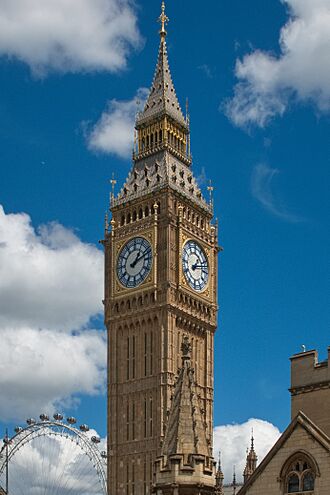
Big Ben, June 2022
|
|
| Alternative names | Elizabeth Tower |
| General information | |
| Type | Clock tower |
| Architectural style | Gothic Revival |
| Location | Westminster, London, England |
| Coordinates | 51°30′03″N 0°07′28″W / 51.5007°N 0.1245°W |
| Completed | 31 May 1859 |
| Height | 316 feet (96 m) |
| Technical details | |
| Floor count | 11 |
| Design and construction | |
| Architect | Augustus Pugin |
Big Ben is a famous nickname. It refers to the Great Bell inside the Great Clock of Westminster. People also use "Big Ben" to mean the entire clock tower itself. This tower stands at the north end of the Palace of Westminster in London, England. It was first called the Clock Tower. In 2012, it was renamed Elizabeth Tower to celebrate Elizabeth II's Diamond Jubilee. The clock is a special kind that strikes the hours with five bells.
The tower was designed by Augustus Pugin. It was built in a Gothic Revival style and finished in 1859. The tower is decorated with stone carvings. These carvings show symbols of the four nations of the United Kingdom. There is also a Latin message celebrating Queen Victoria. The tower is 316 feet (96 m) tall. You have to climb 334 steps to reach the bell room. Its base is square, measuring 40 feet (12 m) on each side. The clock faces are 22.5 feet (6.9 m) across.
The clock uses its original parts. When it was finished, it was the biggest and most accurate four-faced clock in the world. Edmund Beckett Denison and George Airy designed it. Edward John Dent and Frederick Dent built it. The clock is known for being very reliable. You can adjust its speed by adding or removing old pennies from the pendulum. The Great Bell was made by the Whitechapel Bell Foundry. It weighs about 13.5 long tons (13.7 tonnes; 15.1 short tons). The nickname "Big Ben" might come from Sir Benjamin Hall. He was in charge of putting the bell in place. Or it might be named after a famous heavyweight boxing champion, Benjamin Caunt. Four smaller bells, called quarter bells, chime every 15 minutes.
Big Ben is a very important British symbol. It represents the United Kingdom and its government. You often see it in movies set in London. The clock tower has been a protected building since 1970. It became a UNESCO World Heritage Site in 1987. The clock and tower were fixed up between 2017 and 2021. During this time, the bells were mostly quiet.
Contents
The Famous Tower
How the Tower Was Built
The Elizabeth Tower, also known as "Big Ben," was built as part of the new Palace of Westminster. The old palace was mostly destroyed by a big fire in 1834. Charles Barry was the main architect for the new palace. But he asked Augustus Pugin to design the Clock Tower. Pugin's design was similar to some of his earlier work.
Building the tower started on September 28, 1843. The companies that built it were Thomas Grissell and Morton Peto. Pugin finished his design for the tower just before he became ill and passed away in 1852. He said he had never worked so hard in his life.
Tower Design and Features
The tower was finished in 1859. It is designed in Pugin's Gothic Revival style. It stands 316 feet (96.3 m) high. This makes it the third tallest clock tower in the UK. The clock faces are 180 feet (54.9 m) above the ground. The tower's base is square, measuring 40 feet (12.2 m) on each side. It sits on strong concrete foundations.
The tower is built with bricks. It is covered on the outside with sand-colored limestone. The top has a spire covered in hundreds of cast iron roof tiles. Inside, there is a spiral staircase with 290 stone steps to the clock room. Then there are 44 more steps to the bell room (belfry). Another 59 steps lead to the very top of the spire.
Above the belfry, there are 52 shields. These shields show national symbols of the UK. These include the rose of England, the thistle of Scotland, the shamrock of Northern Ireland, and the leek of Wales. They also show other symbols like the pomegranate and the fleurs-de-lis.
A special air shaft runs from the ground up to the belfry. It was designed to bring fresh air into the Palace of Westminster. But it did not work as planned. So, it was used as a chimney for a while. During the 2017–2021 repairs, a new lift (elevator) was put into this shaft.
The tower leans slightly to the north-west. This is because its foundations are on soft ground. Experts believe this lean will not be a problem for thousands of years.

The Ayrton Light
A new light was added in 1873 by Acton Smee Ayrton. He was in charge of public buildings. The Ayrton Light is a lantern above the belfry. It is lit up when the House of Commons is meeting after dark. You can see it from all over London. It was originally meant to shine towards Buckingham Palace. This way, Queen Victoria could see when the government was working.
The Prison Room
Inside the tower, there is a special room called the Prison Room. It has oak panels. You can only get to it from the House of Commons. It was last used in 1880. An atheist Member of Parliament, Charles Bradlaugh, was held there. He had protested against swearing a religious oath to Queen Victoria. Today, this room is used by the Petitions Committee. They handle requests sent to Parliament.
Why the Tower Was Renamed
During Queen Victoria's time, journalists called it St Stephen's Tower. This was because Members of Parliament used to meet in St Stephen's Hall. So, news about the government was called "news from St Stephens."
On June 2, 2012, the House of Commons voted to change the name. They decided to rename the Clock Tower to Elizabeth Tower. This was to honor Elizabeth II during her Diamond Jubilee year. The large west tower, Victoria Tower, had been renamed for Queen Victoria's Diamond Jubilee. The change was made official on September 12, 2012. A plaque was put on the tower to mark the new name.
The Great Clock
Clock Faces and Details
Augustus Pugin got ideas for the clock faces from clockmaker Benjamin Lewis Vulliamy. Each face is made of cast iron parts bolted together. The whole frame is 22.5 feet (6.9 m) across. This makes them the third largest in the UK. Each face has 324 pieces of milky glass.
At first, gas lamps lit the dials from behind. This only happened when Parliament was meeting. But since 1876, they have been lit from dusk until dawn. Electric lights were put in during the early 1900s. The fancy decorations around the dials are covered in gold.
At the bottom of each dial is a Latin message. It says: DOMINE SALVAM FAC REGINAM NOSTRAM VICTORIAM PRIMAM. This means "O Lord, keep safe our Queen Victoria the First." The clock's hour hands are 8.75 feet (2.7 m) long. The minute hands are 14 feet (4.3 m) long.
When the clock was new, the dials and hands were a dark blue color. But in the 1930s, they were painted black. This was to hide dirt from air pollution. During the 2017–2021 repairs, the original color was brought back. Workers found that the clock had been painted six different colors over 160 years. The old glass was also replaced with new glass made in Germany.
How the Clock Works
The clock's inner workings are known for being very reliable. The designers were Edmund Beckett Denison, a lawyer and clock expert, and George Airy, the Royal Astronomer. Edward John Dent started building the clock. After he died, his stepson Frederick Dent finished it in 1854.
The tower was not ready until 1859. This gave Denison time to test the clock. He invented a special system called a double three-legged gravity escapement. This system helps keep the clock accurate. It stops things like rain or wind from affecting the clock hands. Denison never patented his design. It quickly became the standard for other high-quality tower clocks.
On top of the pendulum, there is a small stack of old penny coins. These coins are used to adjust the clock's time. Adding a coin makes the pendulum swing a tiny bit faster. This makes the clock run faster. Taking a coin off makes it swing slower. Adding or removing one penny changes the clock's speed by 0.4 seconds per day. The clock usually stays accurate within a few seconds each week. It is wound by hand three times a week. This takes about 1.5 hours. A special team of clock experts is always ready to fix the clock if needed.
On May 10, 1941, during a German bombing raid, two of the clock's dials were damaged. Parts of the tower's roof were also hit. The House of Commons chamber was destroyed. But the clock kept running accurately and chiming throughout the war.
Times Big Ben Stopped or Had Problems
Past Incidents
- Before 1878: The clock stopped for the first time. This was due to heavy snow on the clock hands.
- 1877–1878: The clock stopped for three weeks for cleaning and repairs.
- February 1900: Heavy snow on a clock face stopped the clock for about eight hours.
- 1916: During World War I, the bells were silent for two years. The clock faces were not lit at night. This was to avoid guiding German airships. The bells rang again on November 11, 1918, to mark the end of the war.
- 1927 and 1928: Snow stopped the clock again.
- 1934: The clock stopped for several hours and was repaired.
- 1936: A painter accidentally stopped the clock by leaning a ladder against a part of the mechanism.
- 1939: During World War II, the clock faces were not lit at night. This was to avoid guiding bomber pilots. But the bells kept ringing.
- 1941: The clock was damaged during a German bombing raid. Stonework and glass were broken. Later repairs found more damage than first thought.
- 1941: A worker repairing bomb damage left a hammer too close to the clock. This stopped it for a day.
- 1944: The clock hands stopped due to a broken part. It was fixed quickly.
- 1945 and 1947: Very cold weather froze parts of the quarter-bell hammers. This stopped the chimes.
- 1949: The clock slowed down by four and a half minutes. A group of birds landed on the minute hand.
- 1955: Snow stopped the clock again. Small heaters were then put inside the dials to help prevent freezing.
- 1955: A rope broke, silencing the clock for several hours.
- 1962: Heavy snow and ice made the clock slow down. It chimed in the New Year nine minutes late.
- 1965: The bells were silent for the funeral of former Prime Minister Winston Churchill.
- 1968: Snow stopped the clock again.
- 1976: A part of the chiming mechanism broke. The Great Clock was shut down for 26 days over nine months. This was the longest stop since it was built.
- 1986 and 1987: The quarter bell chimes froze again.
- 1997: The clock stopped twice around the time of a general election.
Recent Incidents
- 2005: The clock stopped twice, possibly due to hot weather.
- 2005: The clock was stopped for 33 hours for maintenance. This was the longest maintenance stop in 22 years.
- 2006: The "Quarter Bells" were stopped for four weeks. A part holding one of the bells needed repair.
- 2007: The clock stopped for six weeks for major maintenance. Parts of the chime system were replaced for the first time.
- 2013: The bells were silent for the funeral of former Prime Minister Margaret Thatcher.
- 2015: The clock was running seven seconds fast. Workers removed coins from the pendulum to fix it.
- 2017: The chimes were silenced for four years for major repair work.
- 2023: The clock dials stopped and Big Ben did not chime at 1:00 p.m. It was five minutes slow until fixed.
The Famous Bells
The Great Bell (Big Ben)
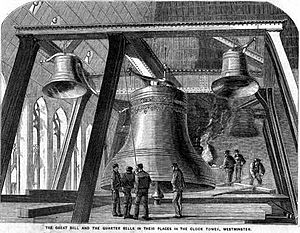
The main bell is officially called the 'Great Bell'. But everyone knows it as Big Ben. It is the largest bell in the tower. It rings an E-natural note.
The first Great Bell weighed 16 tons. It was cast in 1856. People thought it might be named "Victoria." But during a discussion in Parliament, someone suggested "Big Ben." This name stuck.
The tower was not ready yet. So, the bell was set up in New Palace Yard for testing. But it cracked and could not be fixed. A new bell had to be made. The second bell was cast in 1858. It weighed 13.5 tons. This new bell was moved from the factory to the tower. Sixteen horses pulled it. It took 18 hours to pull it up to the belfry. This new bell first chimed on July 11, 1859. But in September, it also cracked. The person who designed the clock had used a hammer that was too heavy.
Big Ben was silent for three years. The hours were struck on a smaller bell. To fix the crack, a piece of metal was chipped out. The bell was then turned a bit. This way, the hammer hit a different spot. Big Ben has chimed with a slightly different sound ever since. The crack is still there. Big Ben was the largest bell in the British Isles until 1881. That's when "Great Paul" was cast for St Paul's Cathedral.
In 2007, the bell's hammer was replaced. This was the first time since it was installed.
Where the Nickname "Big Ben" Came From
The exact origin of the nickname Big Ben is not fully known. It was first used for the Great Bell. It might have been named after Sir Benjamin Hall. He was in charge of putting the Great Bell in place. Or it could be named after the famous English heavyweight boxing champion Ben Caunt.
Today, "Big Ben" is often used to mean the clock, the tower, and the bell all together. However, some people prefer to use "Big Ben" only for the bell.
The Chimes
Besides the Great Bell, the belfry has four quarter bells. These bells play the Westminster Quarters tune every 15 minutes. The four quarter bells sound G sharp, F sharp, E, and B notes. They were cast in 1857 and 1858.
The quarter bells play a 20-note tune. They play parts of it at quarter past, half past, and quarter to the hour. They play the full tune on the hour. The tune's words are: "All through this hour/Lord be my guide/And by Thy power/No foot shall slide." These words are written on a plaque in the clock room.
One rule for the clock was that the first strike of the hour bell had to be correct within one second. This is compared to Greenwich Mean Time. So, at twelve o'clock, the very first strike of the bell marks the hour.
On November 13, 2022, the chimes of Big Ben returned to regular service. This was for Remembrance Sunday. The chimes rang before the hour bell struck at 11:00 a.m. This marked the start of two minutes of silence.
Big Ben's Cultural Importance

The clock tower has become a cultural symbol for the United Kingdom. In movies or TV shows, if someone wants to show a general location in the UK, they often show Big Ben. Sometimes, a red double-decker bus or black cab is also in the picture.
In 2008, a survey found that the tower was the most popular landmark in the UK. It has also been called the most famous film location in London.
The sound of the clock's chimes is also very famous. Many other clocks copy the Westminster Quarters tune. But the sound of Big Ben is seen as the original and best. Big Ben is a main part of New Year celebrations in the UK. Radio and TV stations play its chimes to welcome the new year. For 2012, fireworks exploded from the tower with each chime. On Remembrance Day, Big Ben's chimes mark the 11th hour of the 11th day of the 11th month. This starts the two minutes of silence.
In 1999, a recording of the clock was released as a song. It was called "Millennium Chimes."
Big Ben's chimes have also been used at the state funerals of monarchs. It chimed once for each year of the monarch's life. This happened for King Edward VII, King George V, King George VI, and Queen Elizabeth II.
People who live a certain distance from the tower can hear the bell strike 13 times. This happens if they listen to the live chimes and also to the chimes on an old-fashioned radio. The radio sound arrives instantly. But the live sound is delayed because sound travels slower through the air.
ITN's News at Ten used to start with a picture of the tower. The sound of Big Ben's chimes would mark the news headlines. These chimes are still used during news bulletins. Big Ben also strikes the hour before some news on BBC Radio 4 and the BBC World Service. This started in 1923. The sound comes live from a microphone in the tower.
In 2010, the results of a national election poll were shown on the south side of the tower. On July 27, 2012, Big Ben chimed 30 times. This was to welcome the Games of the 30th Olympiad to London.
2017–2021 Restoration Work
On August 21, 2017, Big Ben's chimes went silent for four years. This was for important repair work on the tower. The bells were silenced to protect the hearing of the workers. This decision caused some debate. For important events like New Year's Eve, the bells were rung using an electric motor. At least one clock face was always kept working and visible. Scaffolding was put up around the tower right after the bells were silenced. The cost of the project was first estimated at about £29 million. But it ended up costing nearly £80 million.
In 2020, workers found that the Elizabeth Tower had more damage than thought. This was from a 1941 bombing raid. They also found asbestos, lead paint, and broken glass on the clock dials. The stone carvings were also badly damaged by air pollution. Fixing these problems added to the cost.
During the work, 2,567 cast-iron roof tiles were removed and fixed. A lift was installed to make it easier to get around. A basic toilet with running water was also added inside the tower for the first time. The Ayrton Light at the top was also fully repaired. It was replaced with energy-saving LED lights.
One of the biggest changes was the color of the clock faces. The black paint was removed. The original color, a dark blue, was brought back. This was the color used when the tower was first built in 1859. The clock faces were re-gilded (covered in new gold). The shields were repainted in their original red and white colors. All 1,296 pieces of glass in the clock faces were also replaced.
In December 2021, after four years of work, the tower appeared from behind its scaffolding. It was ready for the New Year's Eve celebrations. In April 2022, the support structure for the scaffolding was removed.
See also
 In Spanish: Big Ben para niños
In Spanish: Big Ben para niños


